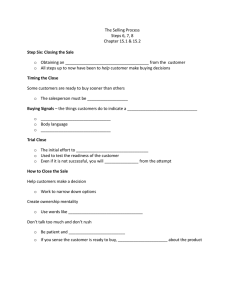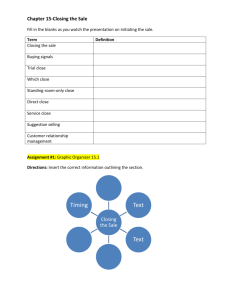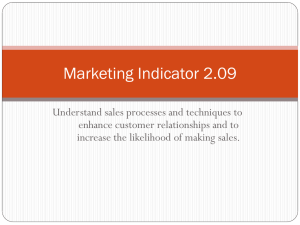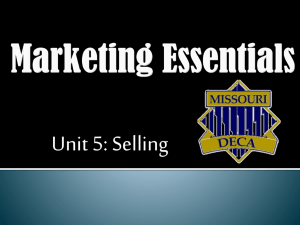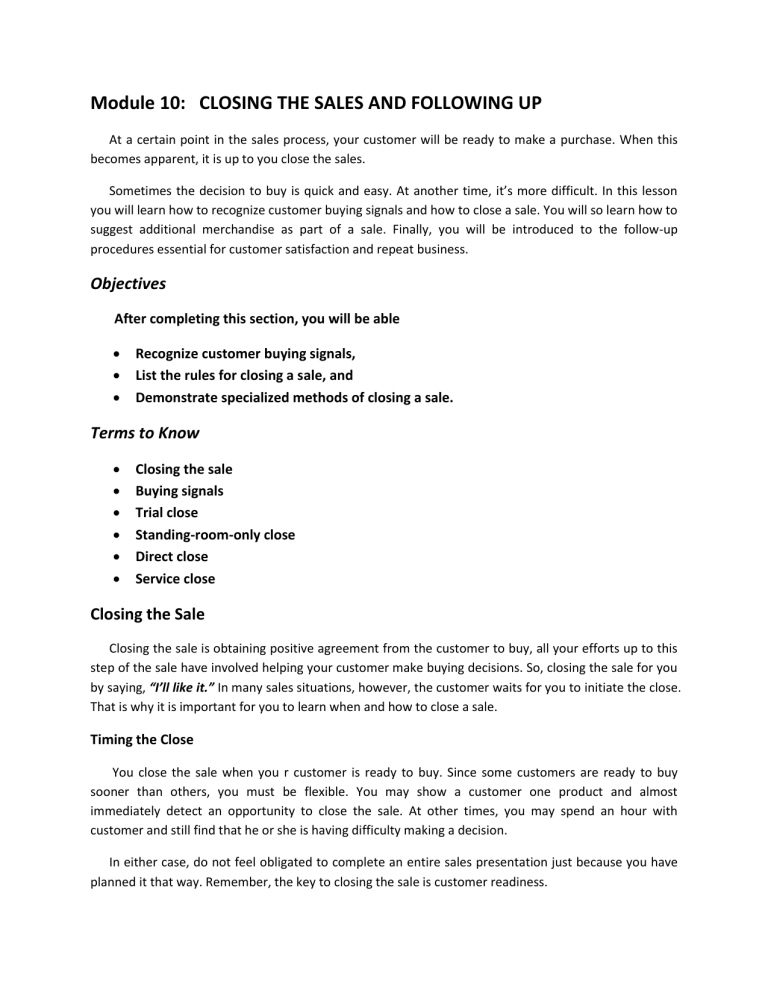
Module 10: CLOSING THE SALES AND FOLLOWING UP At a certain point in the sales process, your customer will be ready to make a purchase. When this becomes apparent, it is up to you close the sales. Sometimes the decision to buy is quick and easy. At another time, it’s more difficult. In this lesson you will learn how to recognize customer buying signals and how to close a sale. You will so learn how to suggest additional merchandise as part of a sale. Finally, you will be introduced to the follow-up procedures essential for customer satisfaction and repeat business. Objectives After completing this section, you will be able Recognize customer buying signals, List the rules for closing a sale, and Demonstrate specialized methods of closing a sale. Terms to Know Closing the sale Buying signals Trial close Standing-room-only close Direct close Service close Closing the Sale Closing the sale is obtaining positive agreement from the customer to buy, all your efforts up to this step of the sale have involved helping your customer make buying decisions. So, closing the sale for you by saying, “I’ll like it.” In many sales situations, however, the customer waits for you to initiate the close. That is why it is important for you to learn when and how to close a sale. Timing the Close You close the sale when you r customer is ready to buy. Since some customers are ready to buy sooner than others, you must be flexible. You may show a customer one product and almost immediately detect an opportunity to close the sale. At other times, you may spend an hour with customer and still find that he or she is having difficulty making a decision. In either case, do not feel obligated to complete an entire sales presentation just because you have planned it that way. Remember, the key to closing the sale is customer readiness. Buying Signals To direct an opportunity to close the sale, look for buying signals. These are things a customer does or says to indicate a readiness to buy. They include facial expressions, actions, and comments. Fox example, a customer who is holding merchandise and smiling is usually sending you buying signals. So is a customer who has removed a jacket from a hanger and draped the garment over his arm. Comments that imply ownership are also buying signals. You know a ready to buy when you hear comments such as “This is exactly what I was looking for.” Trial Close To test the readiness of the customer and your interpretation of a positive buying signal, you can attempt a trial close. This is an initial effort to close a sale. Trial closes are beneficial for two reasons. First, even if the close does not work, you will probably learn from the attempt. The customer will most likely tell you why he or she is not ready to buy. Second, if the trial close does work, you will reach your goal of closing the sale. Thus, in both situations you retain control of the sale and are in an excellent position to continue with sales process. The rule, then, is always be ready to close. Rule 1- If you think the customer is ready to make a buying decision, stop talking about the product. Continuing to sell to a customer who ready to make a purchase may have a negative effect or even cause you lose the safe. Rule 2- When a customer is having difficulty making a buying decision, stop showing additional merchandise. You should also narrow the selection of items by removing those things that are no longer of interest to the customer. You can do this by asking. “Which of these items do you like the least?” once you get the selection down to two, you can concentrate on helping the customer make a decision. Rule 3- Help a customer decide by summarizing the major features and benefits of a product. You can also tell the advantages and disadvantages of the item being considered. Both methods help you to focus the decision making on important considerations. Rule 4- Don’t rush a customer into making a buying decision. Be patient, courteous, polite, and helpful. Always remember that your primary interest is in customer satisfaction. Rule 5- Use words that indicate ownership, such as you and yours. When presenting selling points, say such things as, “You’ll enjoy using this camera on your vacation. Rule 6- Use major objections that have been resolved to close the sale. The effect of having a major obstacle removed usually makes a customer receptive to buying the product or service. Rule 7- Use effective product presentation to close the sale. Dramatic product presentations often prove important selling points and get a customer excited about owning the product. Take advantage of high customer interest at these times and attempt to close. Ask questions such as, “Those walking shoes are comfortable, aren’t they?” In general, if you get positive reactions from the customer throughout the sales process, that same positive frame of mind will help make the closing natural. Specialized Methods for Closing the Sale Once you recognize a buying signal, you should attempt to close the sale. How you go about this depends on the selling situation. Certain selling situations warrant the use of specialized methods. Such as the which, standing-room only, direct, and service closes. Which close The which close encourages a customer to make a decision between two means. To accomplish that goal, follow these three steps. 1. Removed unwanted items to bring the selection down to two. 2. Review the benefits of each item. 3. Ask the customer, “Which one do you prefer?” This method makes it easy for a customer because only one simple decision must be made. Standing-Room-Only Close The standing -room-only close is used when product is in short supply or when the price will be going up in the near future. Because it can be perceived as a high-pressure tactic, this close should be used infrequently and only when the situation honesty calls for it. For example, a shoe salesperson might say, “This is the last pair of shoe I have in your size.” Direct Close The direct close in method in which you ask for the sale. If you followed the rules for closing the sales, you have already obtain agreement from the customer of some selling points. So, it should seem natural to get confirmation on more point. However, it is sometimes necessary to ask non-threatening questions or to make statements to get the customer ready for the close. Here are a few; “Based on what I’ve shown you, how you feel about this product?” if the customer answers in a positive way, you should be ready to take the order. “Can I assume that we’re ready to talk about the details of your order?” or “It appears that you’re pleased with what you’ve seen. Am I correct? Well, then, shall we get started?” you would use these statements if a buying signal is very strong. In other instances, a simple statement such as “That should wrap it up” might be all that is necessary to see if the customer is ready to make decision. Positive statements by the customer in any of the above situations let you know that the direct close is in order. You can continue the closing with few questions that relate directly to the purchase. Start with simple questions regarding the shipping address and delivery dates. Then get down to the specifics of the order such as styles, colors, and quantities of each. In a retail situation, you might simply ask a question regarding payment, such as “How would you like to pay for this purchase-cash, check, credit card or COD? Service Close Sometimes you run into obstacles or instances that require special services in order to close the sale. The service close explains services that overcome obstacle or problem. Such services include gift wrapping, a return policy, special sales arrangements, warranties and guarantees, and bonuses or premiums. Offering something special can also be an effective closing technique, particularly if the customer will save money and/or time as result. Some enticements might include a free roll of film with a purchase of camera or free alterations on a dress. When your business offers the same quality merchandise at the same price as your competitors, your service may be the only factor that affects the buying decision. In such a case, promising better service that the customer is presently getting may help close the sale. Number of Close Attempts Before Quitting 1. 46% close 2. 24% closes 3. 14% closes 4. 12% closes 5. 4% closes Figure above. More than 60% of all sales follow four or more attempted closes. Given this information, what does the pie chart suggest about the selling technique of the surveyed salespeople? Failure to Close the Sale Don’t despair if your initial attempts to close a sale are unsuccessful. You will have more opportunities particularly if you treat your customer with courtesy and respect. Research suggests that perseverance is the way to succeed. In retail settings, invite the customer to shop in your store again. In industrial selling, ask if you may call again. In both situations, remember that every sales contact has the potential to become a sale in the future. QUESTIONS FOR DISCUSSIONS 1. What are the customer buying signals? 2. When is the right time to close a sale? 3. Provide examples for two of the following specialized closing methods. a. Which close b. Standing-room-only close c. Direct close d. Service close 4. Why is failure to close not a true failure? Module 11: SUGGESTION SELLING Suggestion Selling is selling additional goods or services to the customer. It does not mean loading down customers with unneeded or unwanted goods and services. rather, it involves selling customers other items that will ultimately save them time and money or make the original purchase more enjoyable. For example, consider the customer who buys a camera, takes it home, and only then realizes that he or she has no firm for it. That means another trip to the store before the camera can be used. The salesperson would have had a sure sale by suggesting film as an additional purchase. Benefits of Suggestion Selling Suggestion selling benefits the salesperson, the customer, and the company. You benefit because customers will want to do business with you again. Your customer benefits because he or she is more pleased with the original purchase. The firm benefits because the time and cost involved in suggestion selling is less than the cost of making the original sale. To illustrate the last point, consider the two purchases below. The second includes an extra item, a suggestion from the salesperson. Pair of pants P75 Pair of pants P75 ___ Shirt 35 _______________________________________________ Purchase total P75 Purchase total P110 Cost of goods - 37 Cost of goods - 55 _______________________________________________ Gross profit P38 Gross profit P 55 Expenses - 12 Expenses - 15 ________________________________________________ Net profit P26 Net profit P 40 Note that extra time spent on suggestion selling significantly increased the firm’s net profits. Expenses rose but not in proportion to the sales volume. There are two reasons for this. First, less time and effort are needed for suggestion selling compared to the initial sale. Second, certain business expenses (like utilities and rent) remain the same despite the extra sales activity. Rules for Suggestion Selling There are basic rules for suggestion selling. Rule 1- Do suggestion selling after the customer has made a comment to buy but before payment is made or the order written. Introducing additional merchandise before the sale has been closed can create undue pressure on the customer. The only exception to this rule involves products whose accessories are major benefit (like dolls with extensive outfit wardrobes). Salespeople who sell such products often introduce the additional items during the sales process to help close sale. Rule 2- Make your recommendation from the customer’s point of view and give at least one reason for your suggestion. For example, you might say, “If you want to use your camera immediately, you’ll need film for it.” A customer is usually willing to listen to your suggestion when it sounds as though you have his or her best interests at heart. Rule 3- make the suggestion definite. Don’t ask, “Will that be all?” Instead say, “This oil is recommended by the manufacturer for engine.” In most cases general questions such as response. Rule 4- show the item you are suggesting. Merely talking about it is not enough. In some cases, the item will sell itself if you let the customer see and handle it. For example, putting a matching purse next to the shoes a customer just decided to buy can be quite effective, particularly with some commentary. You might say, “This purse matches your shoes perfectly, doesn’t it?” Rule 5- make the suggestion positive. For example, you could say, “This scarf will complement your coat beautifully. Look how perfectly it matches the color and how fashionable it looks on.” You certainly would never say, ‘You wouldn’t want to look at scarves for your new coat, would you?” such as negative statement show a lack of enthusiasm or perhaps confidence on the part of the salesperson. Suggesting Selling Methods There are three methods used in suggestion selling. They are offering related merchandise, recommending larger quantities, and calling attention to special sales opportunities. Offering related Merchandise Related merchandise can be good or service hat a customer should have to increase the use of enjoyment of the original purchase. Introducing related merchandise is probably the easiest and most effective selling method. For most purchases, there are accessory items that can be sold with the original purchase-a scarf to match the blouse or a special service contract for a new appliance. Recommending Larger Quantities In retail selling, suggesting large quantity usually works with inexpensive items or when money, time, and /or convenience will be save. For example, you may tell a customer who wants to buy a pair of pantyhose. “One pair costs, P400, but you can buy three pair for P1000. That’s a saving of P200. Buying three pair will also save you a trip to store next time you need a pair.” In industrial selling, the salesperson may suggest a larger quantity so the customer can take advantage or lower prices or special considerations. In addition to offering a better price per item, some manufacturers also include special services. Buying a certain quantity, for instance, may allow a retailer to take advantage of free freight and/or free advertising. Calling Attention to Special Sales Opportunities As a matter of customer service, salespeople are obligated to communicate special sales opportunities to their customers. This is so even if those opportunities are not related to original purchase. Often they involve new merchandise, special sales, and holiday items. In retail sales, routine routinely inform your customer of the arrival of new merchandise. Regular customers appreciate this special service because they like having the opportunity to see new merchandise before others do. Most shoppers appreciate the opportunity to take advantage of a bargain. Salesperson are obligated to both the store and the customer to pass along such information. For instance, you could comment on a special sale by explaining, “Were having one day sale on all items in this department. You might want to look around before I write up your purchase.” Special occasions and holidays present an opportunity to sell more merchandise. You can suggest gift items to customers around such occasions Christmas, Hanukkah. Valentine’s Day, Father’s Day, and Mother’s Day. In industrial sales situations, sales representatives, often show new items to their customers after they have completed the sale for merchandise requested. Thus, the salesperson has an opportunity to establish a rapport the customer before introducing new merchandise. After- Sales Activities The big thrust companies today is relationship marketing, Relationship Marketing involves the strategies businesses use to stay close to their customers. In today’s competitive marketplace, after sale , activities are important part of this trend. They are used to develop and nurture customer relationships. Today, with competition from all over the world, the loyalty of customers cannot be taken for granted. How does a company stay close to its customer and keep them happy? By having the sale be the first step in developing a relationship, not the final one. So, think of after-sale activities as part of an on-going dialog with customers in preparation for future sales. Taking Payment /Taking the Order Taking payment or take the order with courtesy. Work quickly to complete the paperwork. Avoid saying or doing anything to irritate your customer at this stage of the sale. You have probably heard an annoyed customer say, “Forget the order. I don’t want it anymore.” If you are courteous and efficient, you can usually avoid this type or negative response. Departure Before the customer departs or before you leave your client’s office, reassure the person of the wise buying choices that have been made. If an item needs special care or specific instructions, take the time to educate your customer about it. You may want to remind the customer, for example, that to get the best results from a Teflon coated fraying pan. It is best to preheat the pan. Helpful comments like this will make your customer feel you are interested and concerned. They also help ensure customer satisfaction. Always thank your customers. Even when customer does not buy, express your gratitude fro the time and attention given to you. Invite him or her back to the store, or ask for permission to call again in the near future. Follow-up The follow-up includes making arrangements to follow through on all promises made during the sales process and checking on customer satisfaction with purchase. If you promised a certain delivery date, call the shipping department to confirm it. Then check to make sure that delivery occurs as promised. If there is a problem, call the customer and explain the delay. If you promised to call back in one week, make that notation on your calendar. To check customer satisfaction, phone the customer a week or two after the purchase to see if he or she is happy with it. You can also send a thank you note with your business card attached. In retail sales, note a customer’s preference in color, style, and size, as well as person’s address and telephone number. In industrial selling, record personal information on the buyer’s marital status, children, and /or hobbies to assist with future sales visits. Record changes in buying pattern that may lead to future sales. Evaluation In an effort to improve customer relations, some businesses send questionnaires or call customers to check on how well they were treated by sales and service staff. The results such surveys are passed on sales people so they can improve their technique. Even if your company has such a formal method of reviewing your efforts, you should conduct your own evaluation. After the sales is complete (even if you close the sale), evaluate yourself. Consider everything you did. What were the strong points of your sales presentation? What did you do wrong? How could you have improved your performance? What would you do differently next time? Such object evaluations can help you improve your selling skills. They will enable you to look forward to your next sales opportunity. That kind of attitude will help you become more effective with each new sales contact. It well helps you become more successful. It’s Hard to Say Good-bye It’s even harder when you’ve crossed the cultural divide. In Japan, for example, it is customary to escort guess from home and wait until they actually out of sight before shutting the door. While they are still in sight, it is customary to continue to wave or bow. Any host who fails to observe this ritual risks seriously offending a Japanese quest. QUESTIONS AND DISCUSSIONS 1. What is suggestion selling, and why is it important? 2. Suggest two rules for suggestion selling. 3. Identify three methods used for conducting suggestion selling. 4. What is relationship marketing, and how is it related to the sales process? 5. Why are after-sale activities (such as departure, follow-u, and evaluation) important?

